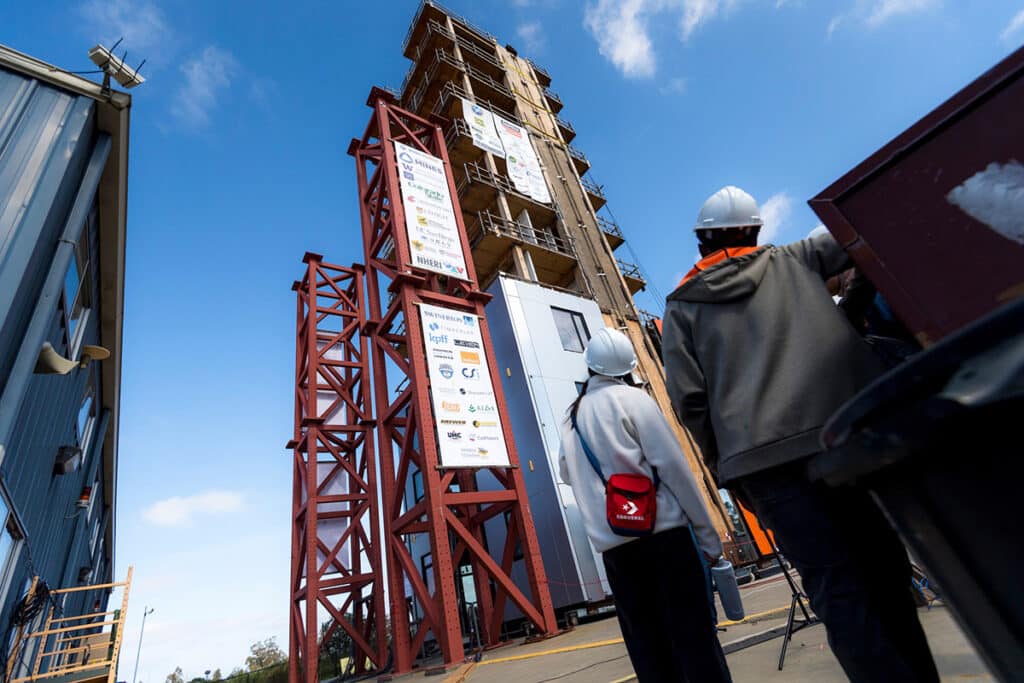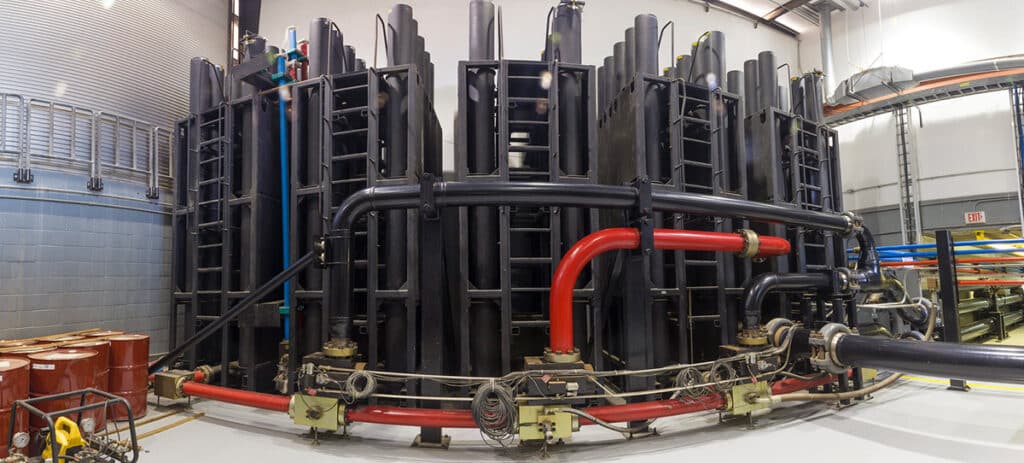Volcanoes are erupting in The Philippines, but on-fire Australia received some welcome rain. The Iran war cries have been called off and The Donald’s military powers are about to be hamstrung by the Senate. Meanwhile, his impeachment trial is starting, and we’re all on Twitter for a front-row seat.
What Could Go Right? Something Seismic
One of the world's largest earthquake simulators is shaking up disaster preparedness.
This is our weekly newsletter, What Could Go Right? Sign up here to receive it in your inbox every Thursday at 5am ET. You can read past issues here.
Something Seismic

Here at The Progress Network, the recent megafloods in Texas have got us thinking again about how underdiscussed aspects of disaster preparedness, such as early warning systems, spell the difference between life and death.
Whether you survive an earthquake or not, for instance, has less to do with luck and more to do with how much a place has invested in preparing for one.
Such investments see dramatic returns in lives saved. A 1999 earthquake in Taiwan, for instance, killed 2,400 people, injured 11,000 more, and caused hundreds of billions in damages. In April of 2024, Taiwan was once again struck by an earthquake similar in magnitude to the one in 1999. But this time, the impact was far less devastating, as progress writer Tony Morley has covered. The 2024 quake killed 19 people and injured 1,100.
Taiwan had spent the quarter-century between the two earthquakes retrofitting buildings and infrastructure to be earthquake-resilient, and ensuring that new construction was built that way, too.
Underneath the hood of a phrase as boring as “building codes” is some very cool science. Building codes have been updated through the years by engineering analysis and experience, essentially seeing what has worked and what hasn’t in previous earthquakes. Since the early millennium, researchers have also been able to stress test new materials and designs before they are built at scale by putting sample buildings through (simulated) earthquakes.
I’d like to introduce you to the coolest thing I saw on the Internet recently, University of California San Diego’s (UCSD) “shake table.” Life-size buildings are constructed and then placed on top of the table, which—as the name indicates—shakes, mimicking real earthquake conditions. The table itself is a steel plate, underneath which is a hydraulic system that powers devices similar to pistons. The plate can hold up to 5 million pounds—several hundred 400 T. rexes, or, more practically speaking, a 10-story building.

UCSD’s shake table is one of the three largest earthquake simulators in the world. (Japan has the largest. That one and UCSD’s became operational around the same time, in 2004/5.) The shake table used to be able to move side to side only, but a 2022 update gave it the ability to behave more like actual ground during an earthquake. Now, the simulator can not only shake east-to-west, but also north-to-south, up and down, and “roll, pitch, and yaw,” according to a UCSD write-up.
Two years ago, UCSD researchers broke the record for the tallest building ever tested on a seismic simulator, a 115-foot one made of engineered wood. Last week, a 100-foot one made of cold-formed steel was put to the test. Cold-formed steel is a material that doesn’t light on fire and is made with 60–70 percent recycled metal. Current building codes allow for up to a six-story cold-formed steel building, but researchers wanted to see if the buildings could safely go up to 10 stories.
Watch the building go through the earthquake simulation, which created seismic waves of up to 6.9 magnitude, here:
Click to play.
Damage assessments are ongoing, but in short, “The building performed very well,” project lead Tara Hutchinson said, with its structural integrity remaining intact. Fire tests are next.
You can see some of the building code updates that research from the UCSD shake table has set into motion on the UCSD website. Much, although not all, of their work is funded by the National Science Foundation (NSF), which congressional spending panels have protected from President Donald Trump’s request to cut its budget in half. Still, NSF is facing a 20 percent cut.
P.S. After last week’s edition on local climate action, it was uplifting to hear from readers all over the country, from Colorado to North Carolina to Virginia, who live in cities and towns with climate action plans and the funding to back them. State-based progress moves on, even as federal policy takes a step back.
What Could Go Right? S7 E19: A Historian’s Look Into America’s Future with Garrett Graff

What can Americans look forward to despite today’s lack of trust in the government? Zachary and Emma welcome Garrett Graff, journalist, historian, and author of several books, including Pulitzer finalist Watergate: A New History. He also hosts the Long Shadow podcast, which covers topics from 9/11 to American far-right extremists. Garrett discusses the power of telling history through the emotion of first-person experiences, the challenges of social media misinformation and government conspiracies, and hope for younger generations of Americans in addressing gun violence and other national issues. | Listen now
By the Numbers
1,400: The number of bald eagle breeding pairs in Maryland, the state with the highest concentration of bald eagles in the United States after Alaska. The population has more than tripled in two decades.
230K: The number of children every year worldwide who are spared from contracting HIV from their mothers, thanks to treatments that became widespread in the early millennium.
10.4M: The number of trees planted in England between 2024 and 2025, the highest level in 20 years.
$16B: The federal investment in child care in the recently passed Big Beautiful Bill.
Quick Hits
🐶 Pet owners in the US now have a long-lasting option to prevent their dogs from getting ticks or fleas. The Food and Drug Administration has just approved a shot that can ward off these parasites for up to a year, a replacement for treatments that need to be administered every month or every few months.
🦫 A biologically dead river in Germany, fouled by human excrement and factory waste, has returned to life after a 5.5 billion euro investment in its cleanup. The project, critically, was backed by local residents, “who were desperate to get rid of the summer stink.” Now the river is home to birds, shrimp, and beavers.
⛴️ You may have seen people riding hydrofoils in the summer, their boards appearing to levitate above the water. Recently, hydrofoil technology, combined with an electric battery, has begun to be tested as a climate-friendly public transport option. Cities from Stockholm to Mumbai are giving electric hydrofoil ferries a try.
🏠 How has Babcock Ranch, an eco-friendly town in southwestern Florida, withstood several high-category hurricanes with very little damage to its homes? The Wall Street Journal shows how its engineers worked with the natural wetlands to build an innovative drainage system that prevents flooding.
🐬 Mexico has banned dolphin and other marine mammal shows nationwide, and Switzerland has become the first country in the world to ban all imported fur or fur products produced using “methods that involve cruelty to animals.”
🫀 It has been possible to grow mini-organs, like the heart, liver, and lungs, in a lab for awhile. But these organoids will need to imitate the real things more closely in order to optimize disease studies or drug tests, and that will entail them being able to grow their own blood vessels. Scientists just made a start.
⚖️ Missouri has become the 16th state in the US to ban child marriage. Meanwhile, despite federal cuts to Medicaid spending on the horizon, 30 states—including several red ones—have expanded or are planning to expand Medicaid funding to cover doulas.
🧒 In the 1970s and 80s, thousands of South Korean children were adopted every year internationally; many of them had their “records falsified to portray them as abandoned orphans,” and some were even stolen from their birth families. Since then, South Korea has struggled to come into line with international standards for safe and ethical adoptions. They will soon take a big step toward doing so, however, in the fall of this year.
👁️ Burundi and Senegal have become the 24th and 25th countries, respectively, to eliminate trachoma, an infectious eye disease that can cause blindness. The number of people requiring antibiotic treatment for trachoma in Africa has been cut in half, from 189 million in 2014 to 93 million in 2024.
🤰 Following a “baby boom” in the pandemic years, ballerinas across the US are beginning to advocate for fairer parental leave policies from their companies. Several, from New York City’s American Ballet Theatre and New York City Ballet to Salt Lake City’s Ballet West, are following through after union renegotiations and updates to state law.
👀 What we’re watching: Australia has opened up a “special mobility pathway” for 280 Tuvaluans each year to travel freely between the two countries and live, work, or study in Australia. The program, considered to be the world’s first climate visa, extends a migration option to the 10,000 Tuvaluans living on an island nation prone to flooding and vulnerable to rising sea levels.
💡 Editor’s pick: Four point six billion years into its life, the New Yorker writes, the sun is having a moment in the form of revolutionizing our energy systems. (This read on why Russian President Vladimir Putin may go down in history as an unintentional hero of green energy is a good accompaniment.)
TPN Member Originals
(Who are our Members? Get to know them.)
- Why do so many people think Trump is good? | The Atlantic ($) | David Brooks
- AI and the trust revolution: How technology is transforming human connections | Foreign Affairs | Gillian Tett
- These USAID awards were saving lives. Reverse the cuts or reissue them. | CGD | Charles Kenny
- Massive study flips our story of addiction and the brain | Scientific American | Maia Szalavitz
- Only a big tent can maximize the OBBBA opportunity | Slow Boring | Matthew Yglesias
- Elon Musk is about to discover that politics is harder than rocket science | GZERO | Ian Bremmer
- Elon Musk’s America Party: Is it Up Wing? | Faster, Please! | James Pethokoukis
- It’s time to let go of ‘African American’ | NYT ($) | John McWhorter
- They’re coming for naturalized citizens | The Preamble | Sharon McMahon
- ICE age | No Mercy/No Malice | Scott Galloway
- The immigration raids in California | Tangle | Isaac Saul
- How to keep on the sunny side of life | The Atlantic ($) | Arthur C. Brooks
- The grip that race and identity have on my students | NYT ($) | Thomas Chatterton Williams
- An interview with the world’s leading gratitude expert | Flourishing Friday | Clay Routledge
- The Central Valley’s ‘Wonderful schools’ | Breaking the News | James Fallows
 The dangerous new nuclear arms race | GZERO | Ian Bremmer
The dangerous new nuclear arms race | GZERO | Ian Bremmer


